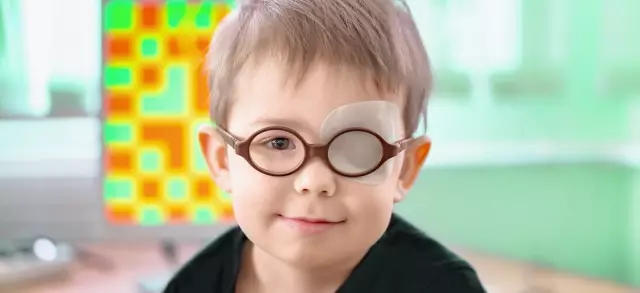- Author Rachel Wainwright [email protected].
- Public 2023-12-15 07:39.
- Last modified 2025-11-02 20:14.
Retinoblastoma

A malignant tumor of the retina of the eye - retinoblastoma, has a neuroectodermal origin and belongs to the group of hereditary diseases. It is transmitted to children from parents in an autosomal dominant manner.
Today, the number of cases of retinoblastoma in children has increased significantly. For comparison: according to official medical statistics, twenty years ago, retinoblastoma in children was diagnosed in 1 case per 30 thousand live newborns, today this figure is 1 case in 10-15 thousand.
A retinoblastic tumor can form anywhere on the retina. At the initial stage, the neoplasm is manifested by a disturbed reflex of the clarity of the fundus. In the next stage of retinoblastoma growth, a flat, turbid formation with blurred outlines is formed. The further development of the tumor depends on its type and the general clinical picture of the disease.
Types of retinoblastoma
According to the type of spread in tissues, specialists subdivide 2 stages of retinoblastoma disease:
1. Stage of endophytic growth (intraocular). At this stage of the disease, a malignant tumor grows inside the eyeball. The growth of the tumor is accompanied by an increase in pressure inside the eye, the appearance of glaucoma, and sometimes the onset of complete blindness. The patient experiences pain, dizziness, nausea, vomiting periodically occurs, in some cases persistent anorexia may form.
2. Stage of exophytic growth (extraocular). At this stage of the disease, malignant growth is not limited to the space of the eyeball. Getting into the intracranial region along the optic nerve, tumor cells spread through the central nervous system, metastases capture the lymph nodes.
In one eye, tumor growth of the two types described above can be simultaneously diagnosed.
There is also a subdivision of retinoblastoma according to the etiology of the disease:
1. Hereditary retinoblastoma. The most common type of disease (over 70 percent of all cases). As a rule, retinoblastoma in children is combined with other multiple congenital malformations - heart defects, cortical hyperostosis, cleft of the soft palate, etc. Hereditary retinoblastoma is characterized by extremely rapid development, a malignant tumor forms simultaneously on two eyeballs.
In most cases, this type of retinoblastoma is detected at an early age (up to 30 months).
2. Sporadic retinoblastoma. It is much less common. The prognosis for this type of disease is more favorable. With sporadic retinoblastoma, one eye is affected, the neoplasm forms locally, i.e., one tumor node is formed (unilateral tumor). Retinoblastoma of a sporadic form may appear at a later age.
Retinoblastoma causes
Unfortunately, the reasons for the appearance of retinoblastoma to date have not yet been thoroughly established (if we are not talking about hereditary cases of this disease). The disappointing trend towards an increase in the number of retinoblastoma diseases clearly indicates the negative impact of the current environmental situation, the low quality of most foodstuffs consumed, causing gene mutations at the intrauterine stage of fetal development.
Retinoblastoma symptoms

Rhinoblastoma disease is accompanied by the following symptoms:
- redness of the eyes;
- pain syndrome;
- dilated pupils;
- partial or complete loss of vision;
- sometimes squint;
- at a later stage of leukocoria - literally means "white eye" (pupillary reflex is not red, as it should be, but white).
Diagnostics of the retinoblastoma
Retinoblastoma is diagnosed in a specialized hospital. Taking into account the early age of patients with retiblastoma, all diagnostic measures and procedures are carried out under general anesthesia. As a rule, physicians prefer not to take cytological and histological samples of diseased tissues, since during the collection of material there is an extremely high risk of instrumental transfer of metastatic cells.
To diagnose retinoblastoma, the following mandatory studies are carried out:
- computed tomography of the brain, eye orbit, eyeballs;
- echography;
- radiography;
- two-projection ultrasound examination of the eyes;
- MRI (magnetic resonance imaging).
How additional diagnostic methods can be used:
- bone marrow puncture;
- puncture of the spinal cord;
- radioisotope examination of bones (osteoscintigraphy).
Retinoblastoma treatment

The tactics of treatment of retinoblastoma depends on the general clinical assessment of the patient's condition, as well as on the stage of formation of the tumor process.
Experts subdivide the stages of retinoblastoma in accordance with the following degrees of severity:
- Stage 1 (tumor formation is limited to the retina);
- Stage 2 (tumor formation is limited to the outside of the eyeball);
- Stage 3 (extraocular);
- Stage 4 (characterized by distant spread of metastases).
After determining the severity of the disease with retinoblastoma, the following therapeutic measures are used:
1. Surgical operation. Refers to at least, it is used in case of one hundred percent loss of visual functions and the complete impossibility of their restoration. As a complex treatment, chemical and radiation therapy are prescribed.
2. Cryodestruction - therapy with low temperatures for retinoblastoma of the mild stage of the anterior part of the retina.
3. Method of photocoagulation. The use of laser beams has a good therapeutic effect in the treatment of retinoblastoma of the mild stage of the posterior retina.
4. Thermotherapy (complex application of microwave therapy, infrared and ultrasonic radiation).
YouTube video related to the article:
The information is generalized and provided for informational purposes only. At the first sign of illness, see your doctor. Self-medication is hazardous to health!






